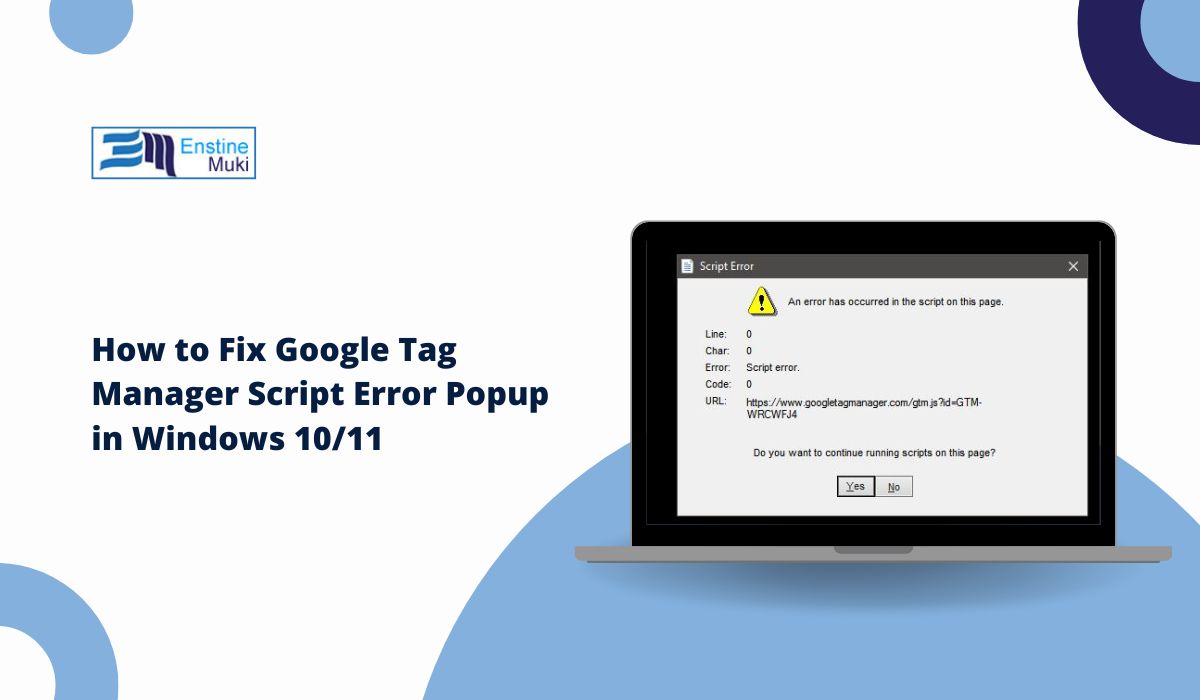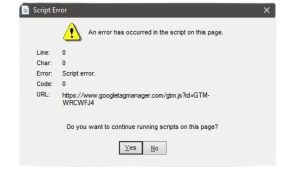Seeing a script error like “An error has occurred in the script on this page” with a URL pointing to Google Tag Manager (GTM)? This is a common issue in Windows environments, especially with legacy browsers or embedded applications.
It doesn’t mean your system is infected or broken, but it does signal that something is interfering with GTM scripts.
Why does This Script Error appear?
The message typically looks like this:
Line: 0
Char: 0
Error: Script error
URL: https://www.googletagmanager.com/gtm.js?id=GTM-XXXX
It means the GTM script couldn’t execute properly. This mostly happens in older browsers or restricted environments.
Common Causes:
- Internet Explorer (IE) or legacy apps using IE rendering
- Disabled script execution in browser settings
- GTM blocked by firewall or antivirus
- Network interruptions while loading the script
- Script conflicts with embedded software (like WebView apps)
- JavaScript errors inside the GTM container
How To Fix Google Tag Manager Script Error Popup in Windows 10/11
Follow these steps to stop the error from popping up again:
1. Use a Modern Browser
This issue is common in Internet Explorer or apps that embed it.
Switch to a modern browser like:
- Google Chrome
- Microsoft Edge
- Mozilla Firefox
If you’re running the script inside an app or dashboard, check if it uses IE for rendering.
2. Disable Script Error Notifications
This won’t fix the underlying problem but will stop the annoying popup:
- Go to
Control Panel > Internet Options - Open the Advanced tab
- Uncheck:
- “Display a notification about every script error”
- “Disable script debugging (Internet Explorer)”
- “Disable script debugging (Other)”
- Click Apply and restart your system
3. Enable Active Scripting
Scripts won’t run if Active Scripting is disabled:
- In Internet Options > Security tab
- Select Internet zone > click Custom level
- Scroll down to Scripting
- Set Active scripting to Enable
- Click OK and restart your browser or app
4. Add GTM Domain to Trusted Sites
This ensures the GTM script loads securely.
How to do it:
- Open Internet Options > Security
- Click Trusted Sites > Sites
- Add:
https://www.googletagmanager.com
5. Check Firewall or Antivirus Settings
Sometimes, security software blocks external scripts like those from Google Tag Manager. This can trigger pop-ups or cause the script to fail.
To fix this, make sure your antivirus or web filtering tool allows connections to googletagmanager.com. Also, disable any script-blocking features temporarily to see if they are the cause.
For testing purposes, you can turn off the antivirus briefly and check if the issue disappears. If it does, adjust the settings instead of keeping protection off.
6. Load GTM in a Browser to Test
Paste the full GTM script URL into a browser. If it doesn’t load, something is blocking it.
For example: https://www.googletagmanager.com/gtm.js?id=GTM-XXXX
If you see a blank or error page, it’s likely blocked by a firewall or proxy.
7. Use Developer Tools to Check Errors
Use DevTools (F12) to see what’s going on behind the scenes:
- Open Chrome or Edge
- Press F12 > Go to the Console and Network tabs
- Reload the page and watch for red errors or blocked scripts
Look for issues related to gtm.js or googletagmanager.com.
8. Remove GTM From Incompatible Apps
Some desktop or hybrid apps still rely on Internet Explorer-based WebView, which often struggles with modern JavaScript like GTM scripts.
In such cases, it’s better to remove Google Tag Manager from that environment entirely. Instead, switch to a lighter tracking script that uses minimal JavaScript.
If tracking is still needed, consider using server-side tagging to avoid direct script execution within the app.
9. Check for Errors in Your GTM Container
If your GTM has broken custom JavaScript, it may trigger this error:
- Log in to Google Tag Manager
- Use the Preview or Debug mode
- Validate all tags and triggers
- Look for uncaught exceptions or syntax errors in custom HTML tags
10. Contact Your Developer or IT Admin
If none of the above fixes work, the issue may stem from deeper system-level restrictions. Your IT team or developer should check for group policies that control Internet Zone behavior, any blocking rules set by Windows Defender or enterprise security tools, and whether the app or platform is using an outdated embedded browser that can be replaced.
Final Words
This GTM script error popup is annoying but fixable. In most cases, switching away from legacy environments or adjusting browser security settings does the trick. If you’re still stuck, disabling the error notification or consulting your IT team may help.
Let me know if you want this in a mobile-optimized format or need a lightweight checklist version.


